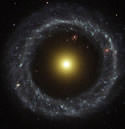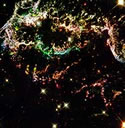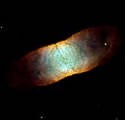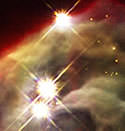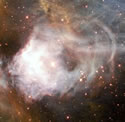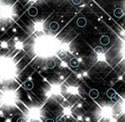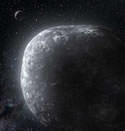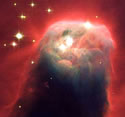
Image credit: Hubble
NASA provided the first pictures today from the newly refurbished Hubble Space Telescope. Among the four new images unveiled to the public today included colliding galaxies, and several nebulas. The Advanced Cameral for Surveys was installed by the crew of the space shuttle Atlantis just a few months ago, and seems to be working well. Operators expect it will be ten times more efficient than the observatory’s previous camera – so far, so good.
“Remarkable, breathtaking” are words jubilant astronomers are using to describe the first four views of the universe taken by the Hubble Space Telescope’s new Advanced Camera for Surveys, released by NASA today.
The new camera was installed on Hubble by astronauts during a shuttle mission last March, the fourth Hubble Space Telescope servicing mission. During five of the most challenging spacewalks ever attempted, the crew successfully upgraded the orbiting telescope with the new camera, a new power unit, new solar arrays and an experimental cooling unit for an infrared camera. Hubble managers say the orbiting telescope has been operating superbly since the servicing mission.
“Today marks the beginning of a new era of exploration with Hubble,” said Dr. Ed Weiler, Associate Administrator for Space Science at NASA Headquarters, Washington. “Our team of scientists and engineers on the ground and the astronauts in space once again did the impossible. After 12 years in space, Hubble not only was given a major overhaul, its new camera has already shown us that, even after 12 years of great science and astounding images, we haven’t seen anything yet.”
Among the suite of four “suitable-for-framing” Advanced Camera for Surveys (ACS) science-demonstration pictures released today is a stunning view of a colliding galaxy, dubbed the “Tadpole,” located 420 million light-years away. Unlike textbook images of stately galaxies, the “Tadpole” ? with a long tail of stars ? captures the essence of a dynamic, restless and violent universe, looking like a runaway pinwheel firework.
“The ACS is opening a wide new window onto the universe. These are among the best images of the distant universe humans have ever seen,” said astronomer Holland Ford of Johns Hopkins University in Baltimore, lead scientist in the camera’s seven-year development.
The camera’s tenfold increase in efficiency will open up much anticipated new capability for discovery. “ACS will allow us to push back the frontier of the early universe. We will be able to enter the ‘twilight zone’ period when galaxies were just beginning to form out of the blackness following the cooling of the universe from the big bang,” said Ford.
The ACS is a camera of superlatives. It is expected to surpass the sensitivity of the largest ground-based telescope to eventually see the very faintest objects ever recorded. The camera delivers a panoramic crispness comparable to that of a wide-screen movie, containing 16 million picture elements (megapixels) per image. By comparison, digital photos from typical consumer cameras are 2 to 4 megapixels.
The ACS image of the Tadpole illustrates the dramatic gains over the Wide Field Planetary Camera 2 resulting from doubling the area and resolution, and demonstrates a five- fold improvement in sensitivity. An unexpected bonus is the enormous number of galaxies in the new Hubble image beyond the Tadpole galaxy, giving it an appearance like the galaxy- filled Hubble Deep Field (HDF) image, taken in 1995. However, the ACS picture was taken in one-twelfth the time it took for the original HDF. Like the Hubble Deep Field, the ACS galaxies contain myriad shapes that are snapshots of galaxies throughout the universe’s 13 billion-year evolution. The ACS images are so sharp astronomers can identify “building blocks” of galaxies, colliding galaxies and extremely distant galaxies in the field ? an exquisite sampler of galaxies.
“The ACS will let us obtain the deepest image of the universe for the foreseeable future,” added astronomer Garth Illingworth of the University of California, Lick Observatory, Santa Cruz, the deputy leader for the camera team.
The other pictures include a stunning collision between two spiral galaxies, dubbed “the Mice,” that presage what might happen to our own Milky Way several billion years in the future when it collides with the neighboring galaxy in the constellation Andromeda. Computer simulations, made by Joshua Barnes of the University of Hawaii and John Hibbard of the National Radio Astronomy Observatory, show that we are seeing the collision of the Mice approximately 160 million years after their closest encounter. Running the simulations forward in time shows that the two galaxies will eventually merge. A similar fate may await the Milky Way and the Andromeda galaxy.
Looking closer to home, ACS imaged the “Cone Nebula,” a craggy-looking mountaintop of cold gas and dust that is a cousin to Hubble’s iconic “pillars of creation” in the Eagle Nebula, photographed in 1995.
Peering into a celestial maternity ward called the M17 Swan Nebula, the ACS revealed a watercolor fantasy-world tapestry of vivid colors and glowing ridges of gas. Embedded in this crucible of star creation are embryonic planetary systems.
In addition to the ACS, spacewalking astronauts installed a new high-tech mechanical “refrigerator” on Hubble during the servicing mission. This “cryocooler” has successfully pumped most of the heat out of the interior of the Near Infrared Camera and Multi-Object Spectrometer (NICMOS), achieving and maintaining to within a few hundredths of one degree the target temperature for neon gas passing through the instrument of 70 degrees Kelvin (minus 203 degrees Centigrade or minus 333 degrees Fahrenheit).
Engineers are now in the process of checking out the operation of the resuscitated NICMOS instrument. By early June, scientists expect to release the first astronomical images taken with the NICMOS since 1998, when it was still being cooled by a rapidly depleting block of solid nitrogen ice.
The new rigid solar arrays, working with the new Power Control Unit, are generating 27 percent more electrical power than the previous arrays. This doubles the electrical power that can be allocated to the scientific instruments on Hubble. The new reaction wheel is operating normally. Nearly a month ago, the Space Telescope Imaging Spectrograph and the Wide Field and Planetary Camera 2 resumed science observations.
“This servicing mission has turned out to be an extraordinary success,” said Preston Burch, Hubble Project Manager at NASA’s Goddard Space Flight Center in Greenbelt, Md. “It was the most difficult and complicated Hubble servicing mission attempted to date and our observatory came through it with flying colors.”
